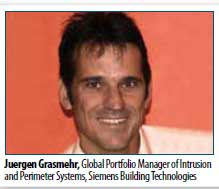After selecting the right products, a few points should be kept in mind during installation. Detector sensitivity, necessary tampering prevention and price/performance considerations should be thoroughly discussed and understood by system integrators and end users.
When installing or upgrading perimeter and intrusion detection systems, the first thing to check are local standards. In the U.S., the Department of Homeland Security outlines new federal security regulations through the Chemical Facility Anti-Terrorism Standards program. Similar efforts are also in place in Canada, as shown by the Canadian Nuclear Safety Commission for nuclear sites. Several countries in the EU also implemented different protection levels — Grade 2 for monitored systems and Grade 3 for public and high risk sites. There is a gradual trend to make EN50131 national security standards mandatory for all intrusion systems that are monitored in Europe.
DON'T BE SO SENSITIVE!
Detection sensitivity is important in an effective perimeter and intrusion detection system. Fine-tuning detector sensitivity is a necessary procedure after installation, as end users do not appreciate a system that is either nonresponsive or overly responsive. Typically speaking, correcting detector sensitivity is to lower nuisance alarm rate (NAR) — alarms caused by an environmental stimulus such as rain, animals or lightning — more so than false-alarm rate (FAR).
 “The install site will have predetermined levels of acceptance for detection, FAR and NAR that the system must achieve,” said David Curtiss, Director of Engineering at Smarter Security Systems. “Initial calibration is generally performed with a specialty tool or human subject. The performance of the system should then be exercised until the requirements are met. After the system is operational there still may be some fine-tuning to find the optimal settings. Generally, within 30 days of installation the hardware will have proven itself and the users will have become familiar with the system operation. Regular maintenance is recommended to ensure proper operation.”
“The install site will have predetermined levels of acceptance for detection, FAR and NAR that the system must achieve,” said David Curtiss, Director of Engineering at Smarter Security Systems. “Initial calibration is generally performed with a specialty tool or human subject. The performance of the system should then be exercised until the requirements are met. After the system is operational there still may be some fine-tuning to find the optimal settings. Generally, within 30 days of installation the hardware will have proven itself and the users will have become familiar with the system operation. Regular maintenance is recommended to ensure proper operation.”
Take fence sensors for instance. Achi e v ing g o od re sul t s i s a combination of site preparation and maintenance work, proper installation and the degree of “smarts” built into the sensor, said Stewart Dewar, PM of Senstar.
“Site preparation ensures that the fence fabric is reasonably tight to minimize excessive movement under windy conditions, and also removes or secures any loose objects striking the fence, such as signs or tree branches,” Dewar explained. “For a fence sensor, proper instal-lation means that the sensor cable is securely attached to the fence and that an appropriate threshold is set. A modern fence sensor will provide Windows software that allows sensor configuration and testing to be done via interactive screens. Modern fence sensors will also use advanced digital signal processing techniques to optimally discriminate between real intrusions and nuisance alarms.”
Sensitivity levels need to be adjusted throughout the day, depending on activities in daytime and nighttime. Also, required sensitivity levels correspond to the threat level of the site protected. This can be configured by setting up different zones, which limits the number of active sensors in the system during daytime — such as acoustic and contacts only — while making all sensors active during nighttime, said Luc Joosens, Detection Product Management Leader for EMEA, UTC Fire & Security. “Another way is to use standard high-sensitivity sensors, such as mirror-optics motion sensors, that are only active during nighttime to ensure maximum sensitivity when required.” 
“Typically this will be done via arming/disarming procedures independently for areas or zones,” added Juergen Grasmehr, Global Portfolio Manager of Intrusion and Perimeter Systems, Siemens Building Technologies. “These procedures can be triggered by users via a management station, field devices such as lock or access readers, or automatically by schedulers.”
Some advanced systems collect information like environmental conditions or special settings — day, night, working time and more — to adjust sensitivity automatically, Grasmehr said.